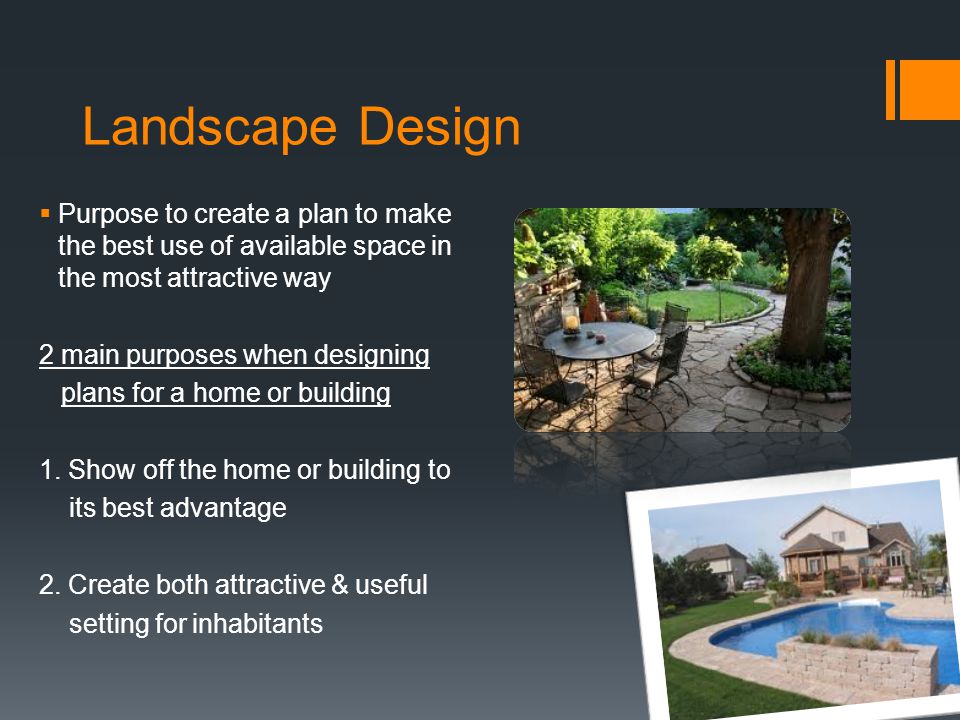Hilton Head Landscapes for Dummies
Hilton Head Landscapes for Dummies
Blog Article
Some Known Facts About Hilton Head Landscapes.
Table of ContentsThings about Hilton Head LandscapesEverything about Hilton Head LandscapesNot known Factual Statements About Hilton Head Landscapes The Definitive Guide for Hilton Head LandscapesThe Hilton Head Landscapes StatementsThe Best Guide To Hilton Head LandscapesThe Best Strategy To Use For Hilton Head Landscapes
Line produces all forms and patterns and can be made use of in a range of methods in the landscape. Line in the landscape is produced by the edge between 2 products, the synopsis or shape of a kind, or a lengthy straight function. Lines are a powerful tool for the developer since they can be used to develop an unlimited range of shapes and kinds, and they regulate motion of the eye and the body.

Lines in the landscape. The properties of lines establish exactly how individuals react to the landscape, both psychologically and literally.
3 Easy Facts About Hilton Head Landscapes Shown
Straight lines are usually found in hardscape sides and product. Rounded lines produce a casual, all-natural, kicked back character that is associated a lot more with nature and asymmetrical balance. Curved lines relocate the eye at a slower speed and include mystery to the area by creating surprise views. Vertical lines relocate the eye up, making a room feel larger.
Vertical lines in the landscape consist of high, narrow plant product, such as trees, or high structures, such as an arbor or a bird residence on a post. Straight lines relocate the eye along the ground aircraft and can make a room really feel larger. Low lines are a lot more restrained and develop a feeling of remainder or repose.
A Biased View of Hilton Head Landscapes
Low lines are developed by reduced garden walls, sidewalks, and short hedges. Lines are used to attract kinds on a plan. In plan sight, they specify plant beds and hardscape areas. Lines are additionally produced by the vertical types of built functions and plant material. There are 3 main line kinds that produce kind in the landscape: bedlines, hardscape lines, and plant lines.
Bedlines attach plant product to your house and hardscape due to the fact that the eye adheres to the line, moving the stare via the landscape. Hardscape lines are developed by the edge of the hardscape, which marks the constructed framework. Line can likewise be developed by long and slim materials, such as a fencing or wall surface.
Hilton Head Landscapes for Dummies
Type is located in both hardscape and plants, and it is commonly the dominant visual aspect that spatially organizes the landscape and typically determines the style of the yard. The type of structures, plant beds, and yard ornaments additionally identifies the total type motif of the garden. Official, geometric forms include circles, squares, and polygons.
Plants produce form in the garden with their details or silhouettes, yet kind can additionally be defined by a gap or adverse room in between plants - bluffton landscaping (https://stevenagonzales5.wixsite.com/h1tnhdlndscps/post/transform-your-outdoor-space-with-hilton-head-landscapes). Circles can be cycles, or they can be split into half circles or circle segments and integrated with lines to create arcs and tangents
The Buzz on Hilton Head Landscapes
Circles can likewise be stretched into ovals and ellipses for even more selection and passion. Circles are a strong style type since the eye is always attracted to the center, which can be made use of to highlight a focal factor or link other kinds. Number 2. Round types in hardscape and lawn panels.
The square kind can additionally be fractional and secondhand repetitively to create a grid pattern. Unlike circles, squares are stronger on the sides, which can be lined up or overlapped to create one-of-a-kind patterns and more complicated forms.
Twisting lines often mimic the all-natural course of rivers or streams and can be referred to as smooth lines with deeply bent undulations. Meandering lines (Number 3) function well for pathways, plant bedlines, and dry stream beds. Meandering lines can include interest and enigma to a yard by leading visitors around corners to uncover brand-new sights and rooms.
All about Hilton Head Landscapes

Number 5. Fragmented sides: stepping stones in pathway. Form is one of the most long-lasting quality of a plant (landscaping hilton head sc). https://www.metal-archives.com/users/h1tnhdlndscps. Typical plant forms are well developed and standard, as kind is the most constant and identifiable quality of plants. Type can also be created via the massing of plants, where the total mass produces a different form than an individual plant.
An extremely contrasting type should be made use of with careone or more work well as a centerpiece, but too several create disorder. All-natural plant types, as opposed to over-trimmed forms, should establish the mass of the structure. The importance of total type is more or much less reliant on the watching perspectivethe type of a tree can show up quite different to a person standing under the canopy versus checking out the tree from a distance in an open area.
The 8-Second Trick For Hilton Head Landscapes
Plant forms also develop and specify deep space or open areas between the plants, developing either convex or concave kinds in the spaces. High-arching tree branches usually produce a concave open area under the branches, and a round cover with reduced branches fills the area to develop a convex form in the open room under the tree.

Report this page